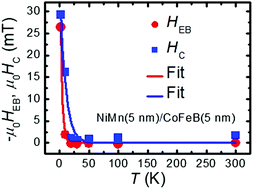Effect of spin glass frustration on exchange bias in NiMn/CoFeB bilayers†
Abstract
Exchange bias in ferromagnetic/antiferromagnetic systems can be explained in terms of various interfacial phenomena. Among these, spin glass frustration can affect the magnetic properties in exchange bias systems. Here we have studied a NiMn/CoFeB exchange bias system in which spin glass frustration seems to play a crucial role. In order to account for the effect of spin glass frustration on magnetic properties, we have investigated the temperature and cooling field dependence of exchange bias. We have observed the decrease of exchange bias field (μ0HEB) with cooling field (μ0HFC) whereas there is a negligible effect on coercive field (μ0HC). Exponential decay of μ0HEB and μ0HC is found in this exchange bias system. Furthermore, training effect measurements have been performed to study the spin relaxation mechanism. We have fitted the training effect data with a frozen and rotatable spin relaxation model. We have determined the ratio of relaxation rates of interfacial rotatable and frozen spins in this study. The training effect data are also fitted with various other models. Furthermore, we have observed the shifting of the peak temperature towards higher temperature with frequency from the ac susceptibility data. The peak temperature vs. frequency data can be described by the Vogel–Fulcher law, which indicates the spin glass like state in the bilayer system.



 Please wait while we load your content...
Please wait while we load your content...